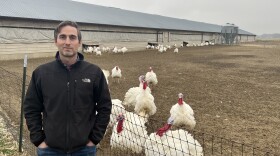-
Ohio’s General Assembly reduced funding to the H2Ohio program in June. The program is designed to protect the state's fresh water from toxic algal blooms and other threats.
-
Ohio's turkey industry brings in over $153 million for the state, setting it at 8th in the nation for turkey production with 273,280,000 pounds produced annually.
-
The Pulitzer Prize-winning journalist returned to the program to show us we can farm better. Art Cullen examines Iowa's agricultural crisis and water pollution.
-
Guided by Mushrooms in Dayton received a $2,500 microgrant from the nonprofit Hall Hunger Initiative to supply mushrooms to House of Bread, a community kitchen offering free lunchtime meals.
-
Farm Safety Net programs typically help farmers access loans, commodity or program payments and disaster assistance — services that have been halted as agencies during the government shutdown.
-
Ohio has seen its hottest August months on record, but the state has also seen some record numbers in rainfall. What does this mean for farmers who rely on the land to produce a fruitful crop?
-
The Black Indigenous People of Color Food and Farming Network’s 2025 Conference will see its second year in Dayton at Central State University’s Germantown Street location.
-
The Ohio State Fair's inclusive pig show event offered people between the ages of nine and 22 with intellectual or developmental disabilities the chance to show pigs in a fair arena.
-
Produce Perks supports more than 150 farms, markets and grocers in Ohio. Some are concerned about the future of the program after more than $5 million in USDA funding for the program was clawed back.
-
Farmers across the state are having to pivot from drought conditions last year to heavy rainfall that has forced many to replant crops.
-
Ohio farmer, Bryna Chandler, is an expert in preserving and using root vegetables months and years after harvest. Now, she's sharing her knowledge.
-
Betty Hoevel is an education coordinator with Five Rivers MetroParks who explained to WYSO how to stretch your summer garden harvest.
Play Live Radio
Next Up:
0:00
0:00
Available On Air Stations












